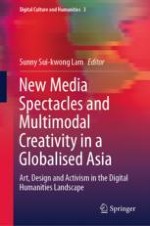2020 | OriginalPaper | Chapter
7. Exploring Cultural Recognition: Enhancing Creativity in Interactive Communications
Author : Amic G. Ho
Published in: New Media Spectacles and Multimodal Creativity in a Globalised Asia
Publisher: Springer Singapore
Activate our intelligent search to find suitable subject content or patents.
Select sections of text to find matching patents with Artificial Intelligence. powered by
Select sections of text to find additional relevant content using AI-assisted search. powered by
